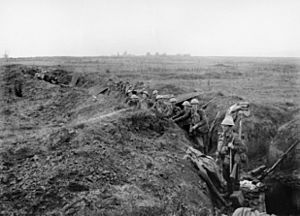Battle of Épehy facts for kids
Quick facts for kids Battle of Épehy |
|||||||
|---|---|---|---|---|---|---|---|
| Part of the Hundred Days Offensive of World War I | |||||||
 The Western Front, 1918 |
|||||||
|
|||||||
| Belligerents | |||||||
|
|
|||||||
| Commanders and leaders | |||||||
| Strength | |||||||
| 12 divisions 1,500 artillery pieces |
At least 6 divisions | ||||||
| Casualties and losses | |||||||
| Total: unknown |
Total: unknown Captured: 11,750 men and 100 artillery pieces |
||||||
The Battle of Épehy was an important fight during the First World War. It happened on 18 September 1918. British and Australian forces, led by General Henry Rawlinson, attacked German positions. These German positions were in front of a strong defensive line called the Hindenburg Line. The village of Épehy was captured by the British on that day.
Why the Battle Happened
Field Marshal Sir Douglas Haig was the top commander of the British forces. He was not keen on starting new attacks. This was because many British soldiers had been hurt or killed. Over 600,000 soldiers had become casualties since March. About 180,000 of these were in the last six weeks alone.
General Rawlinson was told to make sure his soldiers rested. They needed to be ready for the big attack on the Hindenburg Line. But then, good news arrived. The British Third Army won a battle at Havrincourt. This changed Haig's mind.
On 13 September, Haig agreed to Rawlinson's plan. The plan was to clear out German outposts. These were on high ground just before the Hindenburg Line. Preparations for the attack began right away.
The Battle Begins
There were not many tanks available for this attack. So, the soldiers had to rely on artillery fire. This means many big guns would shoot at the enemy. To keep the attack a surprise, the guns did not fire beforehand. Instead, 1,488 guns fired all at once when the attack started. They also used a "creeping barrage." This is when artillery fire moves forward slowly. It moves just ahead of the advancing soldiers. About 300 machine-guns were also ready to help.
Three main groups of the British Fourth Army took part. The French First Army joined them on their right side. The goal was to capture a strong German area. It was about 3 miles (4.8 km) deep and 20 miles (32 km) long. This area had many trenches and strong points. The German 2nd and 18th Armies defended this area.
On 18 September, at 5:20 AM, the attack began. The soldiers moved forward. The French help did not fully arrive. This made it harder for some British units. On the left side, another British group also faced tough fighting. The Germans strongly defended places like "the Knoll" and some farms. However, the British 12th Eastern Division captured the village of Épehy.
In the middle of the battle, Australian soldiers had great success. Two Australian divisions, led by General John Monash, were very strong. They had about 6,800 soldiers. During the day, they captured many things. They took 4,243 German soldiers as prisoners. They also captured 76 guns, 300 machine-guns, and 30 trench mortars. The Australians reached all their goals. They advanced about 3 miles (4.8 km) across a 4-mile (6.4 km) front.
The Australian forces had 1,260 soldiers hurt or killed. This included 265 killed and 1,057 wounded. The battle ended as a victory for the Allies. They captured 11,750 German prisoners and 100 guns.
During the battle, a group of Australian soldiers faced a difficult situation. Most of "D" Company of the 1st Australian Battalion refused to join an attack. They were supposed to help a nearby British unit. The soldiers felt they should have been resting, not fighting again. They had been told they would be relieved soon. On 21 September, 119 soldiers from this company were held for refusing to fight. This was the largest group of Australian soldiers to refuse combat during the war. It showed how tired the soldiers were from long periods of fighting. After the war ended in November, most of the charges against these soldiers were dropped.
What Happened Next
The Battle of Épehy was not the biggest victory. But it sent a clear message. It showed that the German forces were getting weaker. This encouraged the Allies to keep pushing forward. They launched another attack soon after. This was the Battle of St. Quentin Canal. The Allies wanted to attack before the Germans could make their defenses stronger.
Some British forces did not capture their last objectives at Épehy. This made things harder for American forces in a later attack.
Today, you can visit the Deelish Valley Cemetery. It holds the graves of about 158 soldiers. These soldiers were from the 12th (Eastern) Division. They died during this battle. The nearby Épehy Wood Farm Cemetery also has graves of soldiers. These men died in this battle and other fights in the area.

